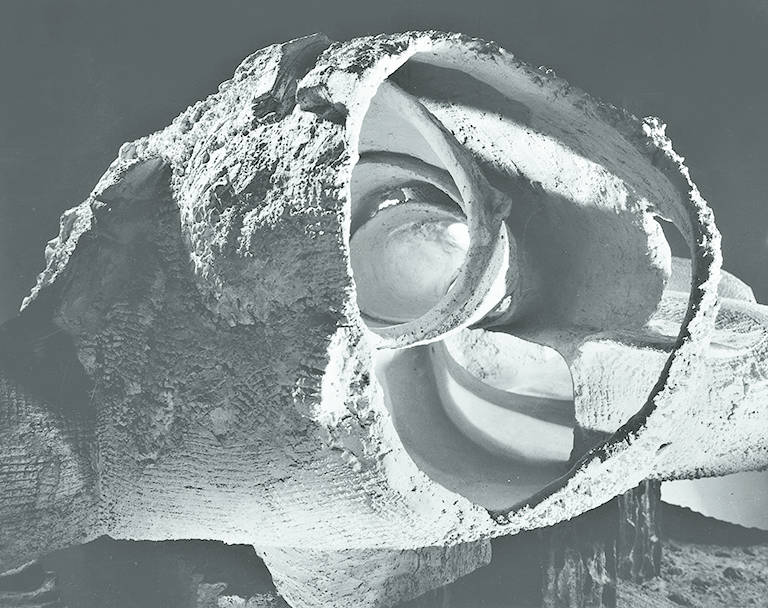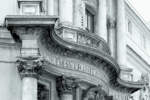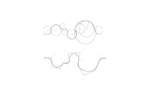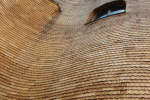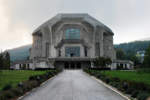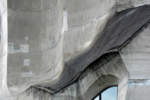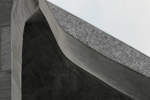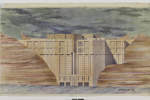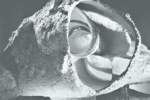The use of computers has resulted in architectural forms in continuous development; even a partial use of them makes it possible to trigger a creative process that, starting with a certain initial idea, succeeds in rewriting the architectural space according to completely new dimensional canons and structural schemes: if this assertion were to be true and irrefutable it would mean that the temporal demarcation between one type of spatiality and another is certainly linked to the use of parametric software and that the change in pace in architecture and its possibility to express highly complex values is certainly linked to the timeline according to which the techniques and means of representation have evolved.
The question therefore consists of clarifying whether and when it has become possible to express a spatial complexity, and above all to realize it; also, is it realistic to think that the use of these forms in architecture is linked to the freedom of expression offered by technology? The challenge for contemporary architectural theory and practice consists of developing, in an increasingly sophisticated way, the environment of this technological development; not simply to have recourse a new assortment of free forms but to allow new spatial relations capable of interpreting a different system of values of living and inhabiting. The classic ideal of realizing architectural forms characterized by permanence and immutability has always been opposed to pursuits of unique and exceptional expressive gestures distinguished by a strong evocative and symbolic charge: some architects have focused on the interpretation of an extremely simple architectural space consisting of a progressive reduction of the elements of classical tectonics and a harmonious perfection, while others have abandoned the trilithic construction frame in favour of more and more surprisingly complex geometries and spatialities, for ever overturning the concepts of surface, limit or separation, to the point of arriving at plastic drifts towards sculptural modelling.
Geometry as means of controlling complexity. It is significant to note that these two different approaches to architectural composition is associated with two different methods of graphic elaboration: on the one side geometry, which decomposes and rationalizes the space into simple and measurable volumes of an Euclidian and Cartesian type, and on the other the geometry that may be defined “non-Euclidean”, which comprises non-linear systems of representation, ranging from elliptic, topological or fractal geometry, fruit of technical-mathematical theories and notions capable of imitating and representing natural phenomena, relegating simple figures to absolutely exceptional contexts.
In fact, “non-Euclidean” geometry and its relative declinations have their origin in a different relationship between architecture and various scientific and technical fields ranging from mathematics to astronomy to biology: conventionally, the architectural form has always been conceived and idealized as representation of a static space, visualized according to a notion of rigid projections of reversals; it is an idealization of reality and is based on a philosophical rationalism that asserts reason’s superiority on the senses. However, already as of 1830 science revealed the limits of this concept, countering the concept of linearity with the variety of “non-linear” processes found in nature, demonstrating that the phenomena took place in anisotropic and not homogeneous spaces undergoing continuous deformation. In spite of the fact that philosophers and scientists have, ever since the time of Plato, thought that primary structures were solids deriving from Euclidean geometry (spheres, cubes, cones etc…) it is realistic, in the light of modern mathematics, to assert that they are based on wrinkled, irregular, non-continuous or rather “non-linear” forms.
To get a clear idea of the concept of complex non-linear space it is important to point out that the historic mathematic interpretation of this term has oscillated over time, in a development parallel to the evolution of scientific discoveries, construction techniques and the desire to represent the forms of nature by imitating them. There is a crucial difference between the discreet geometry of the Baroque space, made of multiple points, and the continuous topological continuity of a non-linear type representing a multiplicity without points created by computer graphics.
San Carlo of the Four Fountains is made of an aggregate of primitive volumes whose tangential juxtaposition form a surface that, even if complex, is of a continuous type, while a topological surface can be represented with an aggregate of concave and convex, pliant surfaces that relate to one another by weight loads that, when varied, change the general arrangement of the whole architectural structure. Every single change in weight load corresponds to a transformation of the original geometric arrangement.
In geometry non-linear transformations generally only retain the geometric properties of the connection and the proximity of points. They are obtained by imagining to draw a figure on a flexible rubber sheet and then to manipulate the sheet in every possible way without tearing it, by curving it, folding it and twisting it. They are continuous non-linear transformations.
The definition of non-linear movements and deformations is very important in architecture because it establishes a clear demarcation between examples of structures that are controlled by means of Euclidean geometry and examples whose representation is the result of a dynamic mathematic method; for instance, in the field of mathematics one has only recently discovered how surfaces can be usefully used as demonstrative models; in fact, it has been observed that the study of complex functions is simpler if visualized through the use of surfaces that can be represented by means of computer graphics.
Formal anticipations of structural experimentalism.
The architectural form has until the 19th century conventionally been conceived within a two-dimensional space of idealized stasis, characterized by fixed points of Cartesian coordinates; today it is characterized by its three-dimensionality thanks to the use of modelling programmes. However, the theory of spatial complexity applied to architecture and its representation is not a novelty from a recent past; it has its origin in experiences of empiric plastic experimentation that anticipated the scientific, mathematic and philosophic theories that were to change of world of constructions by more than 50 years.
Starting from the profound contradictions existing between researches that we could define as tectonic, a category in which we find authors as Schinkel, Semper, Wagner or Beherens, with those of the early works of Maillard, Fuller, Nervi or Wachsmann, it appears defensible to speak of post-tectonic genealogy of use of topological geometry.
Already as of 1922 the German Hermann Finsterlin, one of the first who denied the expressive value of formal complication based on “style” understood as the mask of an epoch, a culture or an ideology, understood that elementary geometric forms had not yet been fully exploited in all their expressive possibilities, because the criteria with which they are used do not include variations of the form or the architectural box, and relate to one another according to the traditional canons of symmetry, axiality, hierarchy etc.
Finsterlin introduced transgressions to the consolidated rules that were capable of unhinging traditional classical spatiality, taking inspiration from a rich and vital world, where the façade and the wall, the roof and the ceiling merge and where plans, elevations and sketches can no longer be represented by straight lines, whose definition still remained approximate and instinctive. In constructive terms these buildings were realized like a skeleton in iron onto which concrete was sprayed from the inside and outside; the spatial concept is based on a distinction of the three dimensions that tends to overcome the functional subdivision of the environments in search of a fluid continuity. His architectures and sketches clearly remind, in an evident and embarrassing way, of the research we today find in many magazines specializing in experiments and theories of so-called digital architecture.
In the same years Rudolf Steiner, who was not an architect by profession but who possessed a very solid scientific preparation and was an authoritative scholar specialized in Goethe, a philosopher and an epistemologist, made his debut on the international stage with the realization of about 10 works, all located on the same hill in Dornach in Switzerland, the most important of which is certainly the Goetheanum; the building was intended as the headquarters for the divulgation of Anthroposophy and its structure was a true book, in which the thought of the philosopher was materialized through the architectural elements, thus laying the foundations for Organic Architecture.
After the fire that destroyed the first wooden building of the Goetheanum and after Rudolf Steiner’s death (1925) the new Goetheanum was completed; it was built in reinforced concrete with absolutely avant-garde technical and artistic solutions.
It must be stressed that the reconstruction in reinforced concrete must be considered an extraordinary feat at a moment when the development of the thin vaults of Nervi and Torroja were still unknown and when Erich Mendelsohn still used bricks to realize his expressionist forms, Steiner was theorizing construction systems for complex forms in reinforced concrete: to produce the formwork for the concrete casts he had to resort to the carpenters of the Hamburg shipyards, who were accustomed to build the convexity of keels with mathematic precision, and to design the curved surfaces he applied mathematical principles to the single curvatures, with the aid of specific logarithmic formulas.
Since the Forties Robert Le Ricolais, who may be considered the father of spatial structures, firmly convinced of the idea that natural forms are more efficient than the simplified ones proposed by Man, theorized on the basis of his philosophical and mechanical studies, that by exploring the insides of certain natural marvels as the Atlantic scallop, water-fleas and mineral crystals it was possible to identify a significant geometric motif, produced as a result of a particular mechanic action.
On the basis of this correlation between mechanical principle and geometric motif, he suggested alternative structural configurations in the form of three-dimensional triangles and hexagons which were characterized by the fact that they anticipated the development of spatial reticular structures used to build numerous contemporary buildings, with the help of calculation software with numeric control of isostatic nodes and rods; it suffices to consider examples as Coop Himmelb(l)au’s BMW building in Munich and the Milan trade fair by Massimiliano Fuksas.
The dissolution of the node into smaller and smaller portions and the plastic quality made possible by the use of reinforced concrete has led to exploration of free spatial effects as those created by Frederick Kiesler: with the intention of re-appropriating an environment that corresponds more closely to reality and nature, he declares his “informal” intention to research a plastic spatiality which, escaping the determination of the definite form, celebrates the irregular, spontaneous and unpredictable; he takes inspiration from the spatiality of natural grottos and underground houses, shifting his ideal towards a primitive ancestral liveability characterized by a continuum, expressed in the project he continued to develop, namely the Endless House (Endless house 1950, Endless house 1960) where he declares the possibility to interact with the external world and with nature by means of a changeable and receptive space capable of accompanying the actions of Man in his dwelling.
He built dozens of large-scale models where he experimented with the structural effect and the morphological characteristics of space: he was among the first to abolish the distinction between floor and ceiling in favour of a plastic continuum; he saw the home as a living pulsating organism, expression of Man’s freedom to live with the rhythms of nature.
An overview of plasticity in architectural forms before computerized design cannot omit to include Eero Saarinen’s Terminal of New York from 1962; the architect realized, on the basis of a documentable planning comprising more than 200 final drawings and a series of contour maps, an incredible sequence of technical plates where the double curvatures were represented on a grid with regular webs; these maps were then used to prepare the construction drawings and the abacuses of the construction elements.
These elaborations were made a short while before the introduction of CAD; computers were in those years only used for structural calculations. The large roof was realized with the help of more than 2700 ashlars and 27 different forms identified by a numeric code; the formwork was realized with multiple ribbings in wood which were curved in two directions, and everything was done with a very high degree of precision; the shifts in alignments were only of a few millimetres. The structural experiments were conducted on large wooden models, some of which were on a scale of 1/5, with empirical load simulations.Speaking of expressionism in a new and contemporary sense of the term, we enter into a borderland between sculpture and architecture. However, if we want to remain on the front of architecture, the problem is to understand to what extent the relationship, or rather the tension, between the “act of moulding” and the “process of building” is coherent and consistent.
The new instruments at our disposal show us the logic which governs the generation of forms, but also the incapacity of the human brain to follow and understand its articulation down to the remotest details. It must be stated that the contribution of digital media has for always shifted our attention, and our gaze is aimed at a future where moulding as invention of a unique, individual, original and unrepeatable form, and construction as assembly of elements subject to a construction discipline based on repeatable and collective procedures, will be possible.
After graduating from the University of Florence with top marks, she obtained her PhD in processes and methods of architectural planning.
After a series of experiences with national and international competitions she began cooperating with the Archea firm in Florence in 1995, becoming a partner in 1999.
She combines architectural research with criticism and theory on the subject, as well as pursuing a didactic career.


